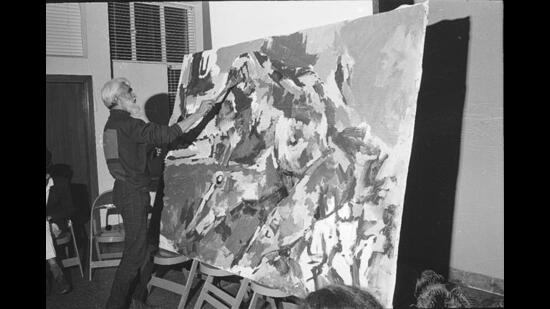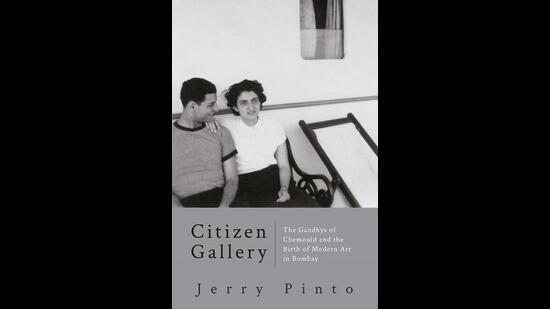Review: Citizen Gallery by Jerry Pinto
At a time when museums thought that the works of Progressive Artists should be hung in toilets, mercurial entrepreneur Kekoo Gandhy believed in modern Indian art. He and his wife Khorshed went on to set up Gallery Chemould. Jerry Pinto’s Citizen Gallery is a biography of the Gandhys and of Chemould, now a byword in the art world.
Before the first galleries came along, the Bombay Art Society and the Sir Jamsetjee Jeejeebhoy School of Art were the two most important art institutions in Bombay. In the 1940s, three Jewish gentlemen, who fled Nazi persecution in Europe and came to India, went onto play a critical role in Bombay’s art scene. They were Rudolf von Leyden, a geologist from Germany, Walter Langhammer, an artist from Austria who became the first art director of The Times of India, and Austrian hat maker Emmanuel Schlesinger.
In 1947, Kekoo Gandhy, along with a Belgian Roger Van Damme, set up a picture framing shop called Chemould Frames on the city’s Princess Street. According to Kekoo’s cousin, Dara Gandhy, Chemould was the first frame moulding factory in Asia.
Around the same time, some Italian prisoners of war, captured in North Africa and interned in Bombay, were put to work painting the messes and club rooms of barracks across India under a scheme called MURART. When the paintings the Italians were doing needed frames, Chemould began to work exclusively for them.

The Progressive Artists Group – comprising the likes of MF Husain, SH Raza and FN Souza – began frequenting the Chemould Frames store. Kekoo also brought in some rich buyers, such as scientist Homi Bhabha and the industrialist Naval Tata. Reportedly, Husain sold his first canvas at Chemould Frames.
On 16th September, 1963, Gallery Chemould opened its doors – an empty space on the first floor of the Jehangir Art Gallery. Its inaugural exhibition was by a growing community of artists that included KK Hebbar, VS Gaitonde and Laxman Pai. That was the beginning of how Chemould sustained and promoted the Progressive Artists Group, often providing them monetary support and keeping them going long before they became famous.
Needless to say, Kekoo loved Bombay, and helped various initiatives to improve the metro’s civic and sometimes political life. Incidentally, he was perhaps the first Indian to have visited Caux, the Moral Re-Armament (MRA) Centre in Switzerland, established at the end of World War II. Kekoo and Khorshed are thus, among the founders in India of MRA, now better known as Initiatives of Change. “Tradition, charm, art, love of country, love of people, a background of privilege and a lifetime of thought for others,” is how their friend Rajmohan Gandhi describes the couple in the book’s Preface.

Pinto recreates well the energy, atmosphere and mood of the time. On the ground floor of the Jehangir Art Gallery was a café called Samovar. “For decades it was where the art community went to meet and talk and gas,” he writes. Further, the Bhulabhai Desai Institute at Breach Candy was another popular space for artists, painters, actors and theatre directors. “So you have to imagine what it must have been like to hear Ravi Shankar at riyaaz on one floor while upstairs MF Husain was painting and outside Ebrahim Alkazi was directing The House of Bernarda Alba while Satyadev Dubey nursed grim thoughts about the monopoly of English over the world of high culture in a multilingual city,” Pinto writes.
Later, the gallery moved to a new bigger space and was renamed Chemould Prescott Road. Today, it is run by the couple’s daughter, Shireen Jungalwala. It continues to champion modern art through the works of several contemporary artists such as Vivan Sundaram, Atul and Anju Dodiya, Jitesh Kallat and Reena Saini-Kallat.

This book about Gallery Chemould and the extraordinary Gandhy family traces the history of modern art in India as a whole. Along the way, the author narrates a number of interesting anecdotes and stories about Bombay’s buildings, architecture and history. “It is also the story of a Parsi couple who wrote their city on the map of the art world with their drive, determination and large-heartedness,” writes Pinto. The book’s release in the 75th anniversary year of the Progressive Artists Group marks a timely and important milestone. Given the vastness of the subject at hand, it is easy to understand why it took more than a decade to be completed.
A freelance writer based in New Delhi, Neha Kirpal writes primarily on books, music, films, theatre and travel.
Enjoy unlimited digital access with HT Premium
Subscribe Now to continue reading

At a time when museums thought that the works of Progressive Artists should be hung in toilets, mercurial entrepreneur Kekoo Gandhy believed in modern Indian art. He and his wife Khorshed went on to set up Gallery Chemould. Jerry Pinto’s Citizen Gallery is a biography of the Gandhys and of Chemould, now a byword in the art world.
Before the first galleries came along, the Bombay Art Society and the Sir Jamsetjee Jeejeebhoy School of Art were the two most important art institutions in Bombay. In the 1940s, three Jewish gentlemen, who fled Nazi persecution in Europe and came to India, went onto play a critical role in Bombay’s art scene. They were Rudolf von Leyden, a geologist from Germany, Walter Langhammer, an artist from Austria who became the first art director of The Times of India, and Austrian hat maker Emmanuel Schlesinger.

In 1947, Kekoo Gandhy, along with a Belgian Roger Van Damme, set up a picture framing shop called Chemould Frames on the city’s Princess Street. According to Kekoo’s cousin, Dara Gandhy, Chemould was the first frame moulding factory in Asia.
Around the same time, some Italian prisoners of war, captured in North Africa and interned in Bombay, were put to work painting the messes and club rooms of barracks across India under a scheme called MURART. When the paintings the Italians were doing needed frames, Chemould began to work exclusively for them.

The Progressive Artists Group – comprising the likes of MF Husain, SH Raza and FN Souza – began frequenting the Chemould Frames store. Kekoo also brought in some rich buyers, such as scientist Homi Bhabha and the industrialist Naval Tata. Reportedly, Husain sold his first canvas at Chemould Frames.
On 16th September, 1963, Gallery Chemould opened its doors – an empty space on the first floor of the Jehangir Art Gallery. Its inaugural exhibition was by a growing community of artists that included KK Hebbar, VS Gaitonde and Laxman Pai. That was the beginning of how Chemould sustained and promoted the Progressive Artists Group, often providing them monetary support and keeping them going long before they became famous.
Needless to say, Kekoo loved Bombay, and helped various initiatives to improve the metro’s civic and sometimes political life. Incidentally, he was perhaps the first Indian to have visited Caux, the Moral Re-Armament (MRA) Centre in Switzerland, established at the end of World War II. Kekoo and Khorshed are thus, among the founders in India of MRA, now better known as Initiatives of Change. “Tradition, charm, art, love of country, love of people, a background of privilege and a lifetime of thought for others,” is how their friend Rajmohan Gandhi describes the couple in the book’s Preface.

Pinto recreates well the energy, atmosphere and mood of the time. On the ground floor of the Jehangir Art Gallery was a café called Samovar. “For decades it was where the art community went to meet and talk and gas,” he writes. Further, the Bhulabhai Desai Institute at Breach Candy was another popular space for artists, painters, actors and theatre directors. “So you have to imagine what it must have been like to hear Ravi Shankar at riyaaz on one floor while upstairs MF Husain was painting and outside Ebrahim Alkazi was directing The House of Bernarda Alba while Satyadev Dubey nursed grim thoughts about the monopoly of English over the world of high culture in a multilingual city,” Pinto writes.
Later, the gallery moved to a new bigger space and was renamed Chemould Prescott Road. Today, it is run by the couple’s daughter, Shireen Jungalwala. It continues to champion modern art through the works of several contemporary artists such as Vivan Sundaram, Atul and Anju Dodiya, Jitesh Kallat and Reena Saini-Kallat.

This book about Gallery Chemould and the extraordinary Gandhy family traces the history of modern art in India as a whole. Along the way, the author narrates a number of interesting anecdotes and stories about Bombay’s buildings, architecture and history. “It is also the story of a Parsi couple who wrote their city on the map of the art world with their drive, determination and large-heartedness,” writes Pinto. The book’s release in the 75th anniversary year of the Progressive Artists Group marks a timely and important milestone. Given the vastness of the subject at hand, it is easy to understand why it took more than a decade to be completed.
A freelance writer based in New Delhi, Neha Kirpal writes primarily on books, music, films, theatre and travel.
Enjoy unlimited digital access with HT Premium
Subscribe Now to continue reading

